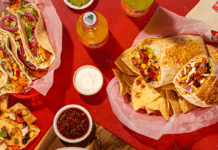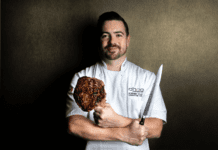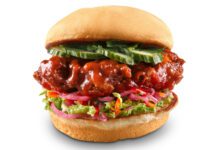David Clanachan, COO at Tim Hortons, is a joker. “We’re this 50-year-old overnight success story,” he says, before adding, “You’re only as strong as your weakest link, and our franchisees work hard to forge strong bonds in their communities. We all work every day to keep that success going.”
In fact, 99.9 per cent of Tim Hortons stores are franchised, with very few corporate locations, (used primarily for training purposes). There isn’t a typical Tim Hortons unit. “We have a saying in our company, ‘We can fit in anywhere.’ It’s not a cookie-cutter model. The canvas we’re given is what we paint on,” says Clanachan. “Some are 1,400 sq. ft. up to 3,000 sq. ft., but at Esso On the Run, we can be as little as 600 to 700 sq. ft., smaller than ever before. We can deliver in smaller, more convenient locations.”
About 65 per cent of the restaurants offer single or double drive-thrus to speed service. Originally conceived to reduce lineups in stores, customers enjoy some unexpected benefits. In bad weather, clothing and shoes aren’t exposed; parents don’t have to unbuckle children and take them inside just to grab a snack; and single women feel safer at night not having to exit their cars. A few express locations are primarily drive-thru without any significant seating.
Understandably, there is a waiting list for franchises, but the company is quick to stress that ownership entails hard work. “If we’re going to be successful, our franchisees have to be successful,” says Roland Walton, president, Tim Hortons Canada. “But the owner-operator piece is critical; they have to be hands-on.”
A network of regional managers and a National Advisory Board, comprised of franchisees from across the country, means decisions can be made with input from all levels. “Franchisee input is critical to the process,” Clanachan emphasizes. “That demands a tremendous cooperative relationship with our franchisees. We believe it’s our job to help them, and it’s their job to carry the brand standard, to deliver on the experience to each and every customer each and every day.”
Miles Mattatall agrees. His family owns 14 Tim Hortons stores in Hamilton and Stoney Creek, Ont. “That’s our job; we get up every day to deliver,” he says. “We have a lot of regulars, and our staff is really good at getting to know them and their orders. That’s key. You can go into some places many times and they still don’t recognize you, but we try to make our customers feel they’re special.
Mattatall has been with Tim Hortons for 47 years. In 1967, his father, Edward, a friend of co-founder Ron Joyce from Nova Scotia, took over the first store on Ottawa Street in Hamilton, Ont., becoming the first official Tim Donut franchisee. Although the unit has been remodelled several times, it’s still in the family. Miles recalls watching founder Tim Horton and Joyce laying concrete blocks in another Hamilton store, hands-on support for their first franchisees.
As a teen, Miles spent one weekend painting the family store with a fresh coat of blue and white paint. Blue and white? Horton was a defenceman for the Toronto Maple Leafs, so those first restaurants were Leafs colours. But, recognizing that hockey players often get traded, Joyce urged a switch to more generic colours. It proved a wise decision when Horton moved to the Buffalo Sabres.
Today, Mattatall’s two sons, Ryan and Christopher, have taken over much of the operational side, and his step-daughter and her husband have also joined the family business, opening two stores in Mississauga, Ont. But even with so many locations, the job remains hands-on. “You have to pace yourself. This is a 24-hour job; it’s not uncommon to get phone calls at 1 a.m.,” says Mattatall. “But it’s a great business. Over the years we’ve seen it grow into a recognized brand. It’s very satisfying, because no two days are ever the same, and you can measure what you do every day.”
Community Involvement
An important part of the role of a Tim Hortons franchisee is a strong commitment to the communities in which they work. Restaurant owners are constantly involved in local events and Tim Hortons logos have become ubiquitous. Tim Hortons Free Skate and Free Swim programs with cooperating rinks and pools allow families to spend time together in winter and summer. The Tim Hortons Earn-a-Bike Program teaches lessons in responsibility and the value of service, rewarding deserving kids who volunteer within their communities with a new bike.
The Timbits Minor Sports Program is a community-oriented sponsorship program for children aged four to eight who participate in local house league sports teams. More than 200,000 children are supported in hockey, soccer, lacrosse, t-ball, baseball and ringette teams across Canada and the U.S. “The program’s philosophy is not based on winning or losing but on learning a new sport, making new friends and taking time out to be a kid,” says the company’s website.
All these activities are simply part of the job, says Mattatall, and at least one of his family members has always tried to be in the cheering section for teams they support. It’s yet another aspect of being a franchisee.
The responsibility could be daunting for the wrong person. One way the company ensures prospective franchisees understand what to expect is to have them meet with owners and work in stores for different shifts. “Not everyone is cut out for it. The trick with franchising is to find a franchisee who shares our vision and beliefs. They have to have a hunger to be entrepreneurial and want to grow,” Clanachan acknowledges. “The good news is the brand owner is here to help and protect and build. But to be a successful franchisee, you have to be engaged in the business — to eat, sleep and breathe it.”
Beyond Canada
Long-term family franchises are not unusual in Tim Hortons, nor are multiple unit owners. But the approach to franchising varies enormously from one part of the world to another. “Canada has an entrepreneurial model; franchisees generally start with one restaurant, then they may expand and get a second,” says Clanachan. “The rest of the world isn’t like that. We’re now looking at partners who want to build several restaurants, in the U.S. and in Dubai.”
The Gulf Cooperation Council has provided fertile ground for Tim’s franchises. There are 38 stores in the region. “We chose the Middle East carefully, because it was the right size and also because there was little like us there,” says Clanachan. “In many other parts of the world, other concepts like ours were already in place and the market was overdeveloped.”
Interestingly, the menus here are nearly the same as Canadian ones, with the exclusion of pork products for religious reasons. The turkey sausage that has proven so successful in the breakfast sandwich in Canada, is having similar success in the region.
In the U.S., franchising began 30 years ago in Buffalo, N.Y., where Horton was playing before his tragic death in a car accident. It expanded slowly, but, in 2008, the company decided to rethink its approach to what is patently a dramatically different market to Canada.
“The U.S. is the largest, most competitive [quick-service] market in the world. We realized that south of the border, you have to be famous for something. So between 2008 and 2010 we positioned ourselves as a café/bakeshop,” says Mike Meilleur, EVP, Tim Hortons U.S.A. “While we remain respectful of our core brand in Canada, we changed the logo slightly, altered the seating, added flat-screen televisions and began introducing specific menu items like the Egg White Breakfast Sandwich, lattes and panini. These all launched in the U.S. and have moved north.”
The transformation gave new life to the brand south of the border and rapid growth has followed. Currently, some 280 franchisees are responsible for nearly 900 stores in 11 states, more than 200 of which are in New York state. Either through modification or new-builds, more than 50 per cent of these are now café/bakeshops.
“We’re at that point in the U.S. where we have a history, and it’s now got incredible vitality. We’re growing markets, and we’re very close to our 1,000 restaurant goal,” says Meilleur, but, he adds, “We’re a long way from the brand recognition we have in Canada. We’re still trying to bring guests in for their first experience. We need to build and drive that loyalty.”
While many American quick-service restaurants woo customers with extra-large portions at extra-small prices, Tims’ philosophy remains the same. “We offer a fair-sized product for a fair price,” he says. “But we keep innovating and offering new products to drive interest.”
Looking for new ways to capture the market continues to drive the chain on both sides of the border. “Product innovation is at the heart of our DNA,” says Bill Moir, chief brand and marketing officer for Tim Hortons. “Today, a new generation of young people, who came into our stores with their parents, [is growing up]. And they love the new products we’re bringing out now, like steak-and-cheese panini. But we have to work on it every day. Complacency is the enemy of greatness; you have to remember the work it took to get you there and keep it up.”




















